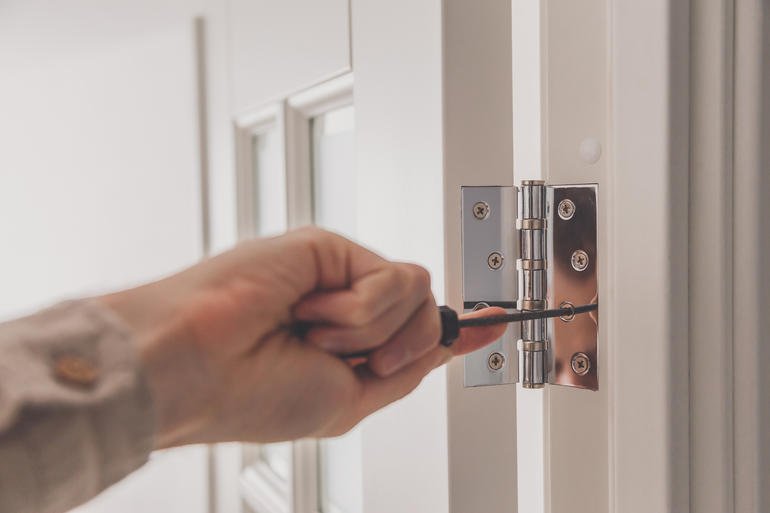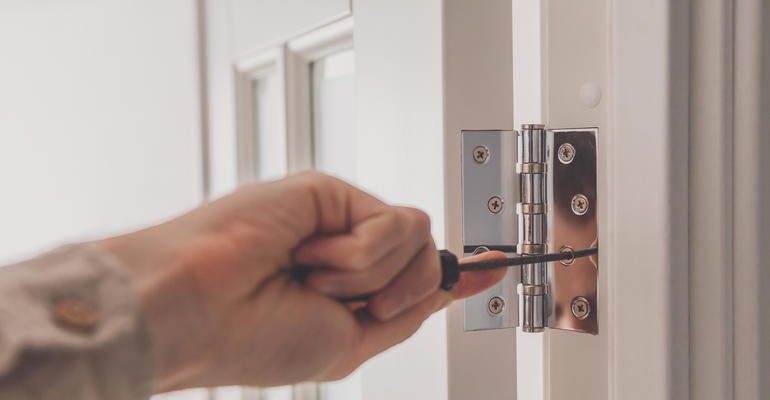
If you have a standard exterior door with Schlage or Kwikset hardware (these are two common brands, but the basic troubleshooting steps apply to most doors out there), the good news is: you don’t need fancy tools or a pro’s skill to get things moving smoothly again. Whether you’re dealing with a new front door or the old back door that’s seen more storms than you can count, a sticky hinge after rain is a perfectly fixable problem. Let’s break down why this happens—and exactly what you can do about it.
Why Do Exterior Door Hinges Get Stiff After Rain?
Rain can mess with metal in a few sneaky ways, especially when it comes to exterior door hinges. Moisture may seem harmless, but it can sneak into the smallest gaps, causing all sorts of issues. First, water acts like a shortcut for rust. Most modern hinges have a coating to help resist rust, but constant exposure—like on a front or back door—can eventually wear that protection down. Once rust gets a foothold, it creates rough spots inside the hinge, making movement tough.
But it isn’t just rust. Sometimes, rain brings in dirt and tiny particles that work their way into the hinge while it’s wet, then dry in place once the weather clears. Over time, this buildup works kind of like sand in your shoes: everything moves, but it’s rough and uncomfortable. And, if your door isn’t hung perfectly or the hinge screws are loose, moisture can make the wood swell a bit, throwing off the alignment and putting extra pressure on the hinge whenever you try to open or close the door.
Honestly, it’s a triple-whammy of rust, grime, and swelling. That’s why it’s common for a Schlage- or Kwikset-brand door to suddenly feel heavier or stiffer after a storm. This isn’t a sign of bad hardware—it’s just nature doing what it does best (making our lives complicated). Luckily, there’s a clear path to a smooth swing.
How To Diagnose The Cause Of A Stiff Door Hinge
Before you fix anything, it’s smart to figure out exactly what’s making your hinge stiff. Otherwise, you might solve one problem and totally miss another. Here’s the thing: not all stiffness is caused by rain, but if it gets noticeably worse after a downpour, moisture is likely playing a part.
- Check for visible rust or discoloration: Open your door wide and look closely at all the hinges. If you see orange streaks or powdery build-up, rust is probably your main culprit.
- Listen for noise: If you hear groaning, squeaking, or grinding, that’s usually a sign there’s dirt or lack of lubricant in the hinge.
- Feel the resistance: Try opening and closing the door several times. If it’s tight only at certain spots, the door or frame may have swelled from the rain, causing things to rub.
- Check screw tightness: Use a screwdriver to gently test the hinge screws. Loose screws can let the door sag or shift, creating more pressure on the hinge when it’s wet.
If you spot any of these signs, you’re on the right track. Even if you don’t see obvious rust, don’t rule it out—sometimes it starts inside the hinge pin where you can’t see it easily. And if your hinges are painted over, older, or a little squeaky, they probably need a bit of attention regardless of what you find.
What You’ll Need To Fix A Sticky Exterior Door Hinge
It’s easy to get overwhelmed by the idea of home repairs, but fixing a stiff hinge is surprisingly simple. You don’t need a whole toolbox—just a few basics you probably already own. Here’s a quick checklist:
- Phillips or flat-head screwdriver (for tightening or removing hinge screws)
- WD-40 or silicone-based lubricant (never use cooking oil or grease—those will only attract more dirt)
- Rag or paper towels (for wiping off excess lubricant, moisture, or rust)
- Fine steel wool or a wire brush (if you notice visible rust)
- Replacement screws (if any are stripped or won’t tighten)
If you need to take out the hinge pin, a small hammer and a nail or pin punch will help. Don’t stress if you’re missing one item—it’s possible to improvise. For example, in a pinch, an old toothbrush can stand in for a wire brush. Just don’t skip the lubricant—that’s what will really make the difference.
Step-by-Step: How To Lubricate and Loosen a Stiff Hinge
Ready to get your door gliding like new? Here’s a step-by-step guide that works for almost any exterior door, whether it has Schlage, Kwikset, or a generic hinge.
- Open the door fully so you can reach the hinge easily. Place a rag under the hinge to catch any drips.
- Apply lubricant (like WD-40 or silicone spray) generously into the hinge space and pin. Aim the nozzle right into the gaps and along the top and bottom of the hinge barrel.
- Work the door back and forth multiple times to help the lubricant spread inside the hinge and break up any grit.
- Wipe away excess with your rag, then listen and feel. If it still feels rough, repeat the spray and swing step.
- For stubborn cases, gently tap out the hinge pin using a hammer and small nail. Clean the pin with steel wool, lubricate it, and replace. Don’t force it—if it sticks, tap gently around the hinge barrel to loosen any stuck spots.
After a few swings, you should notice a world of difference. Doors that once felt like they needed a gym membership start swinging open and closed with almost no effort.
Dealing With Severe Rust or Corrosion
There are times when a simple spritz of WD-40 won’t cut it. If your hinge is really rusty—maybe you see flaking metal or deep orange stains—it may need a little extra TLC. Here’s what to do:
- Remove the pin and, if possible, the entire hinge from the door. (Support the door so it doesn’t drop.)
- Scrub away visible rust using steel wool or a wire brush. Don’t be afraid to spend a few extra minutes here; the cleaner the metal, the smoother the swing later.
- Apply rust-inhibiting lubricant once the metal is clean. This helps protect it from future rain or dampness.
- Reassemble the hinge, replace the screws if they’re rusty, and test the door’s motion.
If the hinge or screws are eaten through with rust (they look pitted, crumbly, or thin), replace them entirely. No amount of oil will save metal that’s already halfway gone.
Sometimes severe rust can also mean a bigger moisture problem around your door—like poor weatherstripping or leaks—so it’s worth double-checking for drafts or puddles after you’re done.
What If The Hinge Is Still Stiff? Other Troubleshooting Steps
If you’ve cleaned, sprayed, and wiggled and your exterior door hinge is still stiff after rain, don’t give up yet. Here are some other issues that might be at play:
- Swollen door or frame: After heavy rain, wood can soak up water and swell, making everything feel tighter. If things loosen up when it’s dry, this is probably your issue. Try sanding the edges lightly or improving weatherproofing.
- Misaligned hinges: If the screws are loose or one hinge is set deeper than the others, the door can bind—especially when wet. Retighten screws or shim the hinge with thin cardboard to get a better fit.
- Paint or caulk buildup: Sometimes paint or old caulk gets inside the hinge during repairs. Carefully scrape away any excess on the hinge barrel or plate.
- Poor-quality or mismatched hinges: Rare, but if you have a new door and old hardware (or vice versa), the pin or barrel might not fit right. Switching to a matched set (like Schlage with Schlage, Kwikset with Kwikset) can often help.
If your efforts still don’t pay off, it might be time to swap in brand-new hinges. Luckily, this is usually an affordable fix and can make a world of difference in both function and appearance.
How To Keep Hinges Swinging Smoothly After Rain
Once you’ve got your exterior door working right, a little prevention goes a long way. The trick is to keep both moisture and grime out of the equation—and that’s easier than you might think.
- Lubricate hinges every few months, especially before wet seasons. A quick spray saves a lot of hassle later.
- Check for leaks or drafts around your door frame. If water is getting in, replacing or adjusting weatherstripping helps keep your hardware dry.
- Clean hinges regularly. Just wipe away visible dirt with a dry rag.
- Use rust-resistant hardware if you live in a rainy area. Brands like Schlage and Kwikset often come with weather-resistant finishes.
Sometimes it’s the little maintenance rituals—like checking a hinge after a storm—that save you from bigger headaches down the line. A three-minute routine every season can mean years of smooth, silent door swings.
When Professional Help Makes Sense
You might be wondering: “Is there ever a time when I really should call a pro?” Most sticky hinges can be fixed at home, but there are a few situations where an expert is worth the call.
- Door won’t close or latch even after repairs: This could mean your frame is warped, not just the hinge.
- Extensive rot, mold, or water damage around hinge area: Deeper structural issues may need repair, not just hinge work.
- Custom or extra-heavy doors: Some doors (like solid wood or older, ornate ones) need special tools or hardware you might not have.
If you’re ever unsure, it’s never a bad move to call a local locksmith or door installer for a quick assessment. They see these issues all the time and can usually spot the problem fast.
Closing Thoughts: Enjoying a Quiet, Smooth Door Again
There’s something oddly satisfying about a door that swings open without a single protest—especially when you know it was sticky just a day ago. Exterior door hinges that feel stiff after rain are more common than you might think, but with some simple troubleshooting, a few tools, and a bit of patience, you can get things running smoothly again. Whether your door uses Schlage, Kwikset, or another common hardware brand, the steps are basically the same: diagnose, clean, lubricate, and check for bigger issues if things still feel off.
Take a few minutes every now and then to show your hinges some love. You’ll be rewarded with a front door that opens gracefully, no matter how hard the rain pours—or how long your grocery-carrying arms are waiting for relief.
